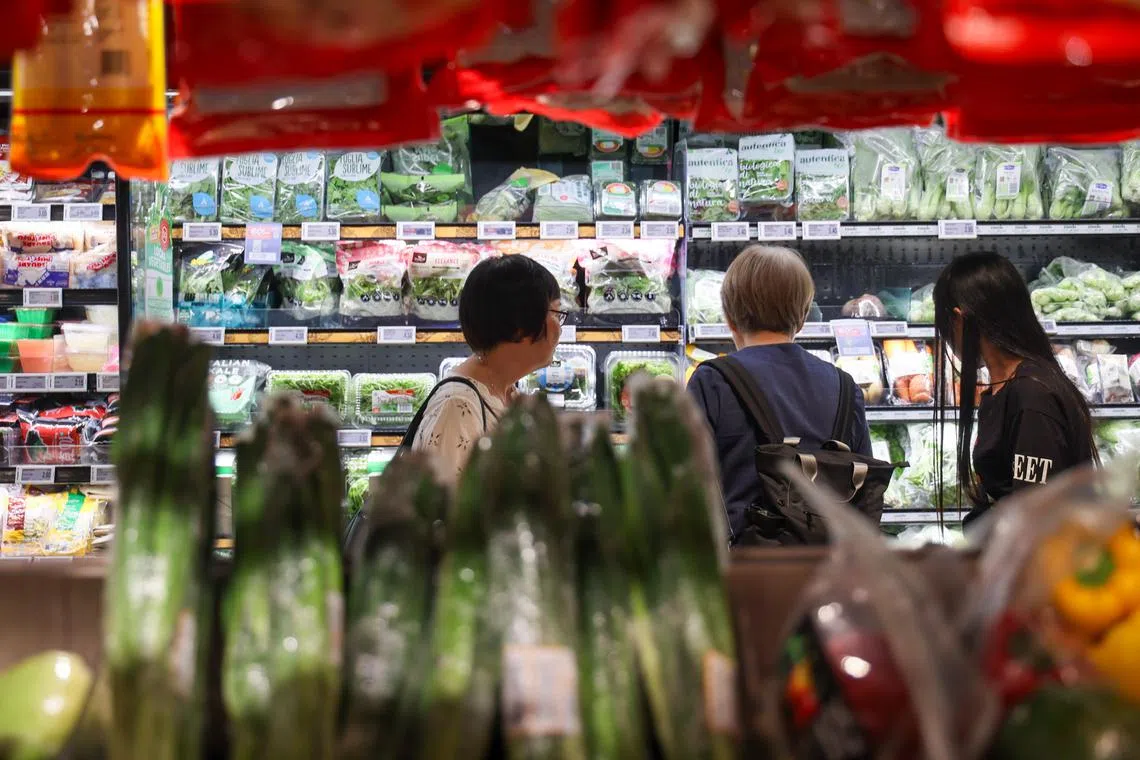MAS keeps Singapore dollar policy unchanged amid US tariff risks to economy
Sign up now: Get ST's newsletters delivered to your inbox

The Monetary Authority of Singapore said that growth momentum over the rest of the year should moderate as front-loading activity dissipates.
PHOTO: LIANHE ZAOBAO
Follow topic:
SINGAPORE – Singapore’s central bank left the pace of the local currency’s trade-weighted appreciation unchanged, after the economy’s surprisingly strong performance in the first half of the year despite the drag from US President Donald Trump’s tariffs.
The Monetary Authority of Singapore (MAS) also kept its forecast for 2025 core inflation – which excludes private transport and accommodation costs to better represent household expenses – at an average of 0.5 per cent to 1.5 per cent.
“MAS will maintain the prevailing rate of appreciation of the S$Neer (Singapore dollar nominal effective exchange rate) policy band. There will be no change to its width and the level at which it is centred,” it announced on July 30.
Unlike other central banks, the MAS manages monetary policy by letting the local dollar rise or fall against a basket of currencies of Singapore’s main trading partners within an undisclosed trading band, which is the S$Neer.
MAS noted that it had eased the pace of S$Neer appreciation twice earlier in 2025 – in January and April – and is now “in an appropriate position to respond to risks to medium-term price stability”.
It also noted that despite uncertainty over the outlook, the global economy and Singapore’s domestic economy have been resilient thus far.
Singapore posted a surprisingly high year-on-year gross domestic product growth (GDP) of 4.3 per cent in the second quarter of 2025, following a 4.1 per cent gain in the first three months – outperforming the Ministry of Trade and Industry’s forecast of zero per cent to 2 per cent growth for the full year.
Meanwhile, core inflation came in at 0.6 per cent in June 2025 on a year-on-year basis, the same level as May.
Ms Sheana Yue, economist at UK-based Oxford Economics, said: “We think the main barrier to looser policy was strong growth momentum last quarter.”
The economic resilience is mostly attributed to US importers booking larger quantities of goods than usual for the first half of the year to mitigate the potential cost increases associated with new tariffs.
The strategy, called front-loading, boosted exports from many Asian countries, including Singapore, to unusually high levels during the period.
However, most analysts believe it is payback time now.
Front-loading would start to fade in the second half of 2025 as importers would tap the stockpiles they had built in the first six months.
Hence, exports and manufacturing output would trail the first-half performance, while inflation would remain mild at best.
MAS also said that growth momentum over the rest of the year should moderate as front-loading activity dissipates.
“In particular, the trade-related sectors should see some pullback, even as activity in the construction sector as well as segments within financial services are supported by a pickup in infrastructure investment and more accommodative financial conditions.”
It said: “Given the uncertainties, MAS will closely monitor global and economic developments, and remain vigilant to risks to inflation and growth.”
MAS said the drag on global demand may also intensify as previously delayed US tariffs are implemented.
“However, the risk of a sharp step-down in global growth in the near term has receded along with the general de-escalation in trade tensions as well as more benign financial conditions since April,” MAS added.
Still, some analysts believe Singapore’s economy will face significant risks as global tariff adjustments could rewire external demand and supply chains, with their impacts extending into 2026.
OCBC chief economist Selena Ling said: “The story really does not end with the reciprocal tariffs or the Aug 1 deadline as there are still many moving parts – there are still sectoral tariffs on copper, semiconductor and pharmaceuticals, among others.
“Our 2025 and 2026 GDP growth forecasts for Singapore currently stand at 2.1 per cent and 2.5 per cent respectively, but the caveat is that US tariffs may have irrevocably shifted global economic dynamics.”
The MAS policy decisions also have implications for the value of the Singapore dollar against other currencies – which is important for Singaporeans planning to travel abroad or making hefty payments such as tuition fees for their children studying abroad.
The Singapore dollar rose 0.14 per cent to 1.2861 per US dollar as at 11.50am on July 30, after the MAS announcement, taking its year-to-date gains to 5.4 per cent.
Analysts said the US dollar has suffered against most currencies, mainly because of the uncertainty around Mr Trump’s reciprocal tariff policy and its impact on the US economy.
DBS Bank said it expects the Singapore dollar to trade within a 1.25-1.30 range versus the greenback for now and end 2025 at around 1.28.
The bank’s senior economist Han Teng Chua and senior currency strategist Philip Wee said in a research note that the Singapore dollar can rise to an 11-year high of 1.26 to a US dollar, after hitting a low of 1.27 early in July.
Given the US dollar’s medium-term downside risks, the Singapore dollar is likely to trade in a stronger 1.20-1.25 range in 2026, he said.


